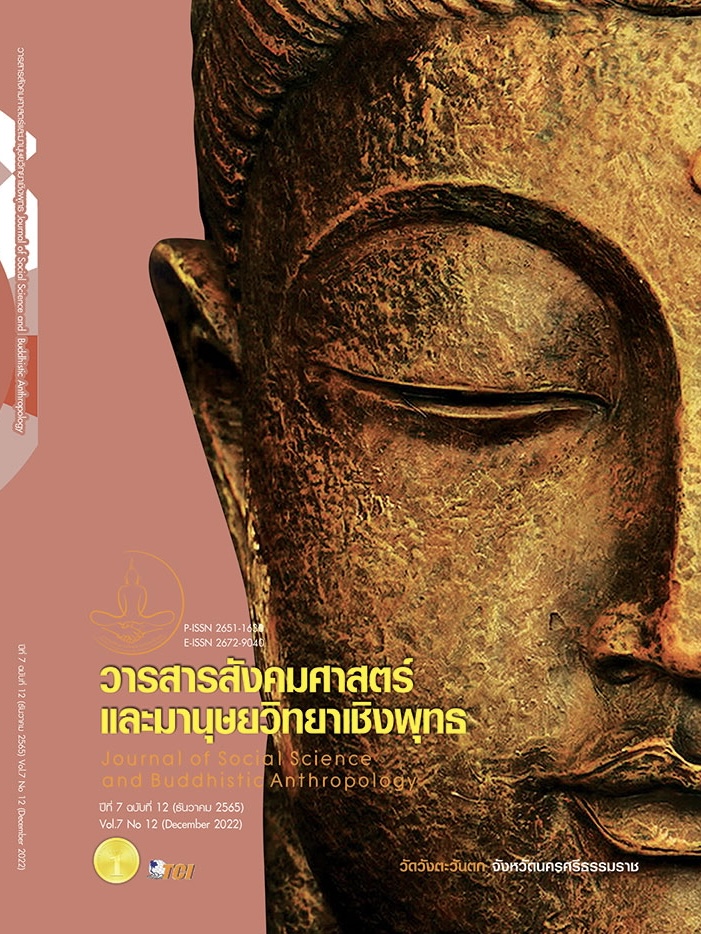การวิเคราะห์องค์ประกอบเชิงยืนยันอันดับสองของโมเดลการวัดการรู้สิ่งแวดล้อมของเด็กปฐมวัยตามแนวคิดการศึกษาอิงสถานที่ CONFIRMATORY FACTOR ANALYSIS EFFICACY ABILITY MEASUREMENT MODEL OF THE ENVIRONMENTAL LITERACY OF PRESCHOOLERS MODEL APPLYING THE PLACE-BASED EDUCATION APPROACH
Keywords:
Model Development , the Place-Based Education Approach, the Environmental Literacy, PreschoolersAbstract
The purposes of this research were 1) to development an efficacy ability measurement model of the Environmental Literacy of Preschoolers Model Applying the Place-Based Education Approach, 2) to examine a validity of efficacy ability measurement model of the Environmental Literacy of Preschoolers Model Applying the Place-Based Education Approach. The research sample included 551 school administrators and teachers in schools service area in 8 provinces of the upper north part of Thailand, who were selected by multi-stage random sampling. The research instrument was a questionnaire. Techniques for analyzing data methods were validity discriminant and reliability by Cronbach’s Alpha Coefficient and confirmatory factor analysis. The reliability of the questionnaire ranged from .951 to .975. The data was analyzed using second-order confirmatory factor analysis. The result was as follows:- 1) The efficacy measurement model of the Environmental Literacy of Preschoolers Model Applying the Place-Based Education consisted of 4 latent variables and 57 observed variables. 2) The variable with the highest correlation was specify a solution and make their opinions based on information about the environment in their locality/community where they live and specify a solution and make comments based on information about the environment in the locality/community where they live and Summarize and prepare the results of knowledge about the environment in the communities where they live and the variable with the lowest correlation is Knowledge of plants, animals, soil, water and air according to the context in which children live. with summarizing and producing knowledge about the environment in the community where they live 3) A model was consistent with the empirical consideration and the goodness of fit indices were within the specified criteria as following : = 30.27, df = 20, p = 0.06, RMSEA = 0.23, CFI = 0.99, GFI = 0.99 และ AGFI = 0.99
References
กรมส่งเสริมคุณภาพสิ่งแวดล้อม. (2544). พระราชบัญญัติส่งเสริมและรักษาคุณภาพสิ่งแวดล้อมแห่งชาติ พ.ศ. 2553 และกฎหมายที่เกี่ยวข้อง. กรุงเทพมหานคร: เอ็นเจ โปรโมชั่น.
กรมส่งเสริมคุณภาพสิ่งแวดล้อม. (2550). แผนหลักสิ่งแวดล้อมศึกษาเพื่อการพัฒนาที่ยั่งยืน พ.ศ.2551-2555. กรุงเทพมหานคร: กองส่งเสริมและเผยแพร่ กรมส่งเสริมคุณภาพสิ่งแวดล้อม กระทรวงทรัพยากรธรรมชาติและสิ่งแวดล้อม.
ชูศรี วงศ์รัตนะ. (2561). เทคนิคการสร้างเครื่องมือวิจัย: แนวทางการนําไปใช้อย่างมืออาชีพ. กรุงเทพมหานคร: อมรการพิมพ์.
พิรุณ ศิริศักดิ์. (2554). การพัฒนารูปแบบการเรียนการสอนวิทยาศาสตร์สิ่งแวดล้อมตามแนวคิดการศึกษาอิงสถานที่ เพื่อส่งเสริมสัมผัสด้านสถานที่และการรู้สิ่งแวดล้อมของเด็กมัธยมศึกษาตอนต้น. ใน ดุษฎีนิพนธ์การศึกษาดุษฎีบัณฑิต สาขาวิชาการศึกษาปฐมวัย. จุฬาลงกรณ์มหาวิทยาลัย.
วราพร ศรีสุพรรณ. (2539). มูลนิธิโลกสีเขียว ในพระอุปถัมภ์ของสมเด็จพระเจ้าพี่นางเธอเจ้าฟ้ากัลยาณิวัฒนา กรมหลวงนราธิวาสราชนครินทร์. สิ่งแวดล้อมศึกษา. (พิมพ์ครั้งที่ 2). กรุงเทพมหานคร: โอเอก พริ้นติ้ง เฮาส์.
สำนักงานคณะกรรมการพัฒนาการเศรษฐกิจและสังคมแห่งชาติ. (2561). ยุทธศาสตร์ด้านการสร้างการเติบโตบนคุณภาพชีวิตที่เป็นมิตรต่อสิ่งแวดล้อม. กรุงเทพมหานคร: สำนักนายกรัฐมนตรี.
สำนักวิชาการและมาตรฐานการศึกษา. (2560). หลักสูตรการศึกษาปฐมวัย พุทธศักราช 2560. กรุงเทพมหานคร: โรงพิมพ์ชุมนุมสหกรณ์การเกษตรแห่งประเทศไทย.
Bellanca, J., & Brandt, R. . (2010). 21st century skill: Rethinking hoe students learn. Bloomington: Solution Tree Press.
Blanchard, P. B., & Buchanan, T. K. . (2011). Environmental stewardship in early childhood. Childhood Education, 87(4), 232-238.
Chawla, L., & Cushing, D. F. (2007). Education for strategic environmental behavior. Environmental education research, 13(4), 437-45.
Ebersole, M., & Worster, M. (2007). Sense of place in teacher preparation courses: place-based and standard-based education. The Delta Kappa Gamma Bulltin, Winter, 73(2), 19-24.
Gruenewald, D.A. (2003). Foundations of Place: A Multidisciplinary Framework for Place-Conscious Education. American Educational Research Journal, 40(3), 619-634.
Gruenewald, D.A., & Smith, G.A. (2007). Place-based education in the global age. New York: Lawrence Erlbaum Associates.
Hair, J. et al. . (2014). Multivariate Data Analysis. (7th ed.). USA: Pearson New International Edition.
NAAEE. (2011). Developing a framework for assessing environmental literacy. Washington, DC: Author.
Palmer, J., & Neal, P. . (1994). The handbook of environmental education. Chatham, NJ: Mackeys of Chatham.
Roth, C. E. . (1992). Environmental literacy: Its root, evolution and directions in the 1990s. Washington, DC: Office of Educational research and Improment.
Sobel, D. (2013). Place-Based Education: Connecting Classrooms and Communities. (2nd ed.). USA: The Orion Society.
UNESCO. (2007). The UN Decade of Education for Sustainable Development 2005-2014. Retrieved July 5, 2022, from http://portal.unesco.org/education/en/ ev.php-URL_ID-48712&URL_DO=DO_TOPIC&URL_SECTION=201.html
Downloads
Published
How to Cite
Issue
Section
License
Copyright (c) 2022 Journal of Social Science and Buddhistic Anthropology

This work is licensed under a Creative Commons Attribution-NonCommercial-NoDerivatives 4.0 International License.








